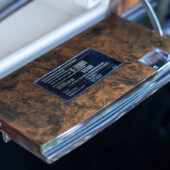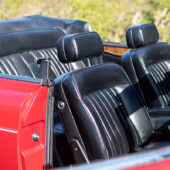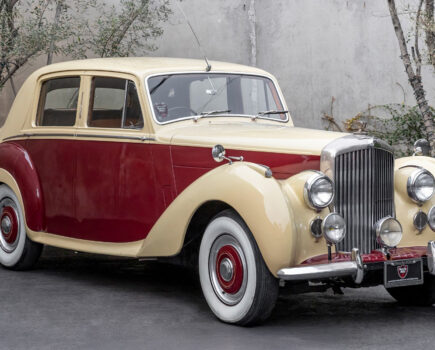The Continental nameplate is one Bentley returned to time and again, yet the least-known variant is the most luxurious
Words: Nigel Boothman Images: Gregory Owain
The car that comes to mind when you hear ‘Bentley Continental’ must vary with the age of cars that interests you most, and perhaps on your own age. Those with a fondness for the great classics would be picturing a fastback R-type by Mulliner, or perhaps one of the glamorous drophead coupés built on S2 or S3 chassis. Those who admire the potency and driver appeal of 21stcentury Bentleys will be thinking of the Continental GT or GTC, the car on which Bentley’s current success and record sales are based. There may indeed be those who thought of the mighty Continental R and T of the 1990s and early 2000s. But would there be anyone, apart from the owners, who pictured this Bentley version of the Rolls-Royce Corniche?
Other marques have made similar repeats with a favourite name. You could waste half an hour tracking all the Aston Martins with ‘Vantage’ attached to them, either as a state of tune or a model name, while Alfa Romeo must have produced at least a dozen different cars called Spider, Giulietta or Giulia. How many Daimler (or Jaguar) Sovereigns were there? Never mind. It’s a tactic that works well if used properly: you get a favourable waft of heritage attached to a new product, and you identify the car’s role in the company’s line-up. When it’s taken a bit more cynically – as a free leg-up to a higher profile and greater sales – it can tarnish a reputation, or at best, leave customers nonplussed. One wonders what fans of Ford’s traditional V8 pony car make of an electric SUV called the Mustang Mach E.
Sticking to Rolls-Royce Motors Ltd, you might wonder why the decision was taken to apply the name to a model already so well established. The first Bentley T and Rolls-Royce Silver Shadow Mulliner Park Ward Convertibles were delivered in 1967, then renamed Corniche Convertible for both marques in 1971. So they remained, until word went out in 1984 that the Continental nameplate would soon be reappearing on the Bentley version. It would be fascinating to know where the idea was born and who gave it final approval, but we can draw conclusions from what else was going on at the time. With the creation of the Bentley Eight (a less sumptuously kitted-out alternative to the Mulsanne and Silver Sprit that beat the psychologically important £50,000 mark), Bentley was receiving attention.
Crewe’s sales chief Peter Ward wanted it to be seen as a rebirth, with a return to some of the sporting ideals of Bentley’s greatest days. The stir caused by the Mulsanne Turbo was the ideal wave on which to ride. For 1985, there would be the new Turbo R (the R quietly understood to indicate Roadholding) to address criticism of the Mulsanne Turbo’s roly-poly handling, the slightly more accessible Bentley Eight and the Bentley Continental. The Continental received more than just a new badge on the back; there was a new fascia layout launched first in the USA, colour-keyed bumpers and grille, and improved seats. Hardly Earth-shaking changes, but when you look at the sales figures, you have to admit it worked.
From 1979 to 1984, only 27 Bentley-badged Corniches were sold. For the whole production run of the Corniche I (Series II), starting in 1977, 2017 Rolls-Royce Corniche Convertibles were sold versus just 31 Bentley versions. The Bentley looked irrelevant. Then, during the first four years of the Continental, 177 were sold, despite an ever-increasing price that kicked off at £76,108 at launch and swiftly rose. You could point to an economic boom in the second half of the 1980s, and to a rise in luxury car sales in general, but the difference for this one model was undeniably stark. It was cool to buy Bentley again, and while sales were still a fraction of the Rolls-Royce numbers, they were a much larger fraction.

What is the Continental like in the flesh – was the difference from a Corniche something that went more than skin deep? In order to find out, we borrowed this 1987 example from Vintage & Prestige in Northampton, where Simone Della Corte generously allowed us to take it on an extended run through the local countryside around the Althorp Estate.
At first sight, it’s a bright and rather attention-grabbing car. The Acrylic Tudor Red seems somewhat showy when teamed with the grille and bumpers of the same colour, with extra glamour emanating from that thick white pinstripe and the whitewall tyres. Indeed, when we posted photos of the car on the RR&BD Facebook page, the reaction was a little mixed, with some people suggesting it was ‘too much’ for those with traditional tastes.
That, you suspect, is exactly why its first owner bought it. In 1987 we’d reached something of a peak in conspicuous consumption, and there was no shame in demonstrating your success with status symbols like this. Remember whale-tailed Guards Red Porsche 911s, bought to match the braces of the City traders who drove them? Well, this car’s first owner is listed as Concorde Financial Services of London EC2, so that’s very much the world for which it was created. It passed through a couple more owners, including John Reid Enterprises between 1990-’91. Reid was Elton John’s manager, so is this another ex-Elton John car? Sometimes it’s harder to find a Corniche that hasn’t been owned by Sir Elton, rather like Lamborghinis and Rod Stewart.
The history folder is immense, with an exhausting sheaf of invoices totalling more money than it’s polite to mention, but which seem to explain the car’s amazing condition for the 75,000 miles it’s showing. Also in the file is a note from the Rolls-Royce historian and RR&BD contributor Marinus Rijkers, explaining this car’s unusual in-between status.
It was first registered on May 15th 1987, one of just five Continentals built for the UK market that year, this being number three. Most went to America and the Far East, then as now. As Marinus says, the Corniche and Continental were upgraded with a new dash in the American market, though the rest of the world had to wait a while longer. This car, with the old Silver Shadow II dashboard but the Corniche II mechanical specification, is very rare in this configuration.
It doesn’t feel like an older fascia, to be honest. The cabin is a feast of black leather, black carpet and darkly figured walnut veneer, interspersed with a mixture of traditional chromed knobs and switches, and green LED readouts from some gauges and the stereo. The steering wheel has a more up-to-date look than the slim two-spoke device from the 1960s and ‘70s. As mentioned, the Corniche II mechanical specification is all present, and it’s quite important.
Chief amongst these is the Bosch fuel injection, adding about 15% to the power output (now between 240 and 250bhp at peak, it’s reckoned), giving the engine the instant starting and mood-free operation that buyers were expecting and indeed demanding. Compliance with emissions regulations in key markets might have been the cause for this somewhat overdue upgrade, but the driver felt a real benefit.
Elsewhere on a Corniche II / Continental, interior furnishings changed again with a larger centre console, electric seat adjustment with memory settings, and numerous other small details. Yes, the car’s shape was anything but current, so Rolls-Royce worked harder and harder to keep it fresh. The Corniche II lasted until 1989, the Corniche III only two years for 1990 and ’91, the Corniche IV from 1992 to ’95 and the enticing turbocharged Corniche S and its Bentley counterpart, the Continental Turbo Convertible, just a few months in 1995 as only 33 examples across both marques were sold as run-out models.

It starts at the first flick of the key, the fuel injection doing its job. In fact, you soon notice how the injection makes a huge difference throughout the rev range and in all conditions, pulling cleanly and allowing access to great stores of torque in an instant, in whatever gear and whatever engine speed. The Continental overtakes like a modern car, if it needs to, but in fact the greatest difference with an older Corniche variant is the steering. You no longer have to drive a two-door convertible like a big, soft saloon; it doesn’t need you to. You needn’t tip-toe into fast bends any more, just sweep through at 60mph, the car going where it’s pointed while most of the old body roll is gone.
Partly this is down to the rack-and-pinion steering that came along with the Silver Shadow II and had been an established feature of the Corniche for a while by 1987, but it’s also down to the spring rates, which feel similar to those on a Turbo R. But firmer springing and damping leads to one of the car’s two flaws – it accentuates the scuttle shake. The roofless Shadow variants were never terribly stiff, but now you find that some of our nastier road surfaces have this one trembling. On smooth tarmac though, it’s wonderful, and on balance this is the compromise I’d go for: a much better driving experience, even if you try harder to avoid potholes.
The other flaw? It’s the wind noise from this roof when it’s erected. It works brilliantly in almost all respects, being snug, neat, tight and well-fitted, with no danger of water leaks and it looks particularly handsome from the rear-three quarter when in place. It rises and falls automatically at the touch of a button and is secured only by two easy-to-reach catches on the cant rail. But it whooshes and whistles at anything over 50mph, so I’d much so that I’d rather drive it with the roof down. That’s fine on a sunny day, especially if you keep the side windows up to stop yourself getting buffeted, but it takes away from the car’s abilities as an eater of motorway miles, especially in poorer weather. Perhaps it’s just a quirk of this car, or indeed a minor fault in alignment or fit that could be corrected, but then this car has one or two other unsolved mysteries for me, as well.
Simone Della Corte thinks the Bentley Continental received a few more brake horsepower and a slightly firmer ride than the Rolls-Royce Corniche, but I can’t find this written down anywhere. Having driven this car, and a few Corniches of various ages, I’m tempted to agree with him. It does feel more responsive in all departments. But how much of that is just the power of association with the Bentley name, with this purposeful black cockpit or just the result of subtle tweaks by previous owners, it’s impossible to say. After all, we are attempting to assess a 36 year-old classic as though it were a new car, which is a lot to ask, even of a machine in this outstanding condition.
The reaction we get from dog-walkers, pedestrians and other motorists as we tour the Northamptonshire lanes and lawns is interesting. Some look mildly put out by this large, ostentatious car in their midst but most peer straight in through the windscreen to see if it’s anyone famous. They are, of course, disappointed. Once, when a wrong turn took us into a beautiful and clearly very expensive golf club, no-one looked twice at us. Just the normal sort of car to park there, it seems. Personally, I find the looks a step too far towards 1980s excess and I would have to choose a Corniche variant that looked older, more traditional. Could I find one that drove as well as this fuel-injected, firmly-damped Continental? I doubt it.

Where does a Corniche-Continental sit now in the hierarchy of Rolls-Royce and Bentley classics? It has rarity on its side, as all Bentley-badged cars originating in the SY generation had. In the last few years of production, the numbers built dropped back to unsustainable levels. Corniche sales had been plummeting after 1992, with the Bentley version suffering in particular, for two pretty obvious reasons: a deep recession and the announcement of the Bentley Continental R in March 1991. We can only imagine the discussions involved in that decision, but with hindsight it seems akin to a self-inflicted wound: here is a new car called the Bentley Continental, which is faster and more exciting than the very much older Bentley Continental Convertible we also sell, yet only slightly more expensive. Oh, and it probably won’t be long before a convertible version of the new car is launched.
In the end, it was three further model years before the Azure appeared and the Corniche / Continental Convertible was laid to rest. The model had been in production for 29 years by then, and the world had moved on so far that the Azure was not a direct replacement. It was a cabriolet version of a fast and well-poised grand touring car, with performance and a ride/handling set-up that kept it apart from anything with a Rolls-Royce grille, and indeed from Continentals like this one. For those who loved the Corniche for its exceptional comfort and grace, and who didn’t need to pin their passengers to the seats with vivid acceleration or press-on roadholding, there was nothing left in the range. When the Corniche V appeared in 1999, it was reckoned softer than its sister car, the Azure, but it wasn’t quite the same experience as the old Corniche. What’s more it was based on a Bentley – the first and last Rolls-Royce with that distinction.
But we’re getting side-tracked…the Rolls-Royce and Bentley variants of the original Corniche lasted as long as they did because people loved them and continued to aspire to own one long after they should have been outdated. Today, they’re valued highly, and if anything, are rising in worth. Fascinating variants like this Continental add more choice to an interesting market. It represents an intriguing option for anyone who is drawn to the more dashing image of the Flying B, without straying far from that peak of indulgence the Corniche delivers. Long may they last – all of them.




































